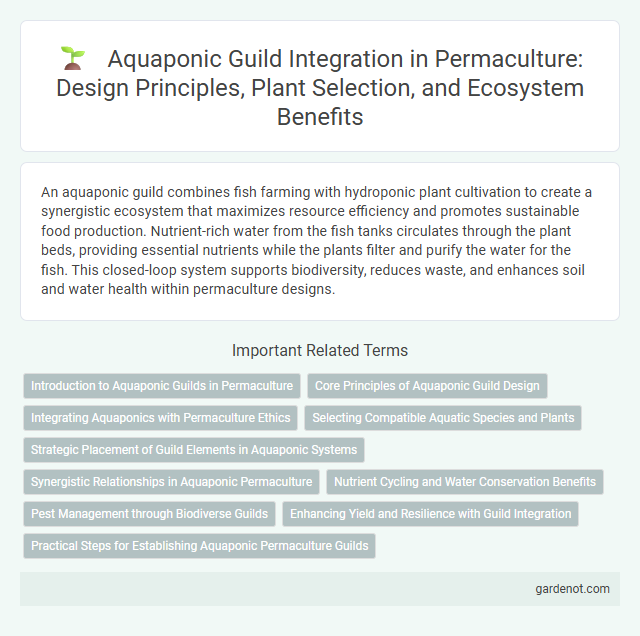An aquaponic guild combines fish farming with hydroponic plant cultivation to create a synergistic ecosystem that maximizes resource efficiency and promotes sustainable food production. Nutrient-rich water from the fish tanks circulates through the plant beds, providing essential nutrients while the plants filter and purify the water for the fish. This closed-loop system supports biodiversity, reduces waste, and enhances soil and water health within permaculture designs.
Introduction to Aquaponic Guilds in Permaculture
Aquaponic guilds in permaculture integrate aquaculture and hydroponics to create a balanced ecosystem where fish waste provides nutrients for plants, while plants purify water for fish. This symbiotic system enhances resource efficiency, reduces waste, and supports sustainable food production in urban and small-scale settings. Key components include nitrogen-fixing plants, nutrient accumulators, and beneficial microbes that optimize water quality and plant growth.
Core Principles of Aquaponic Guild Design
Aquaponic guild design integrates aquaculture and hydroponics to create a self-sustaining ecosystem that maximizes nutrient cycling and water efficiency. Core principles include balancing fish stocking density with plant nutrient demands, selecting complementary plant species that enhance water quality and pest control, and optimizing system architecture to ensure efficient water flow and waste filtration. Emphasizing biodiversity and symbiotic relationships fosters resilience and productivity within the aquaponic guild.
Integrating Aquaponics with Permaculture Ethics
Integrating aquaponics with permaculture ethics creates a sustainable food production system that mimics natural ecosystems by combining fish farming and hydroponic plant cultivation. This synergy enhances nutrient cycling, reduces water usage by up to 90% compared to traditional agriculture, and promotes biodiversity within controlled environments. Applying principles such as care for the earth, care for people, and fair share ensures resilient, productive guilds that support long-term ecological balance and food security.
Selecting Compatible Aquatic Species and Plants
Selecting compatible aquatic species and plants in an aquaponic guild requires understanding the symbiotic relationships that enhance ecosystem health and productivity. Fish such as tilapia, catfish, or trout thrive alongside plants like basil, mint, or lettuce, which naturally filter water by absorbing nitrates and providing habitat. Choosing species with complementary oxygen, pH, and nutrient needs ensures efficient nutrient cycling and stable water quality in permaculture systems.
Strategic Placement of Guild Elements in Aquaponic Systems
Strategic placement of guild elements in aquaponic systems maximizes nutrient cycling and water efficiency by positioning nitrogen-fixing plants near fish tanks to enhance growth and water quality. Combining complementary species such as leafy greens, herbs, and beneficial microorganisms fosters a balanced ecosystem that supports fish health and plant productivity. Optimizing spatial arrangement reduces resource competition while improving airflow and light penetration, ultimately increasing overall system resilience and yield.
Synergistic Relationships in Aquaponic Permaculture
Aquaponic guilds integrate fish, plants, and beneficial microbes to create a self-sustaining ecosystem characterized by synergistic relationships that enhance nutrient cycling and water quality. Fish waste provides essential nutrients for plants, which in turn filter and purify the water, supporting microbial communities that promote plant growth and disease resistance. This interconnected system maximizes resource efficiency and yields, exemplifying the principles of aquaponic permaculture through mutualistic interactions among its components.
Nutrient Cycling and Water Conservation Benefits
Aquaponic guilds integrate fish and plant systems to enhance nutrient cycling, where fish waste provides essential nutrients for plant growth, reducing the need for synthetic fertilizers. This symbiotic relationship maximizes nutrient uptake, improving overall system efficiency and boosting biomass production. Water conservation benefits arise from the recirculating design, significantly reducing water usage compared to conventional agriculture by continuously filtering and reusing water within the system.
Pest Management through Biodiverse Guilds
Aquaponic guilds leverage diverse plant and animal species to create balanced ecosystems that naturally suppress pest populations. Integrating fish species with predatory insects and pest-repellent plants enhances biological control, reducing reliance on chemical pesticides. This biodiversity-driven approach promotes sustainable pest management, improves system resilience, and supports healthy aquaponic production.
Enhancing Yield and Resilience with Guild Integration
Aquaponic guild systems maximize productivity by integrating fish, plants, and beneficial microbes in a symbiotic environment, enhancing nutrient cycling and reducing waste. This guild integration promotes resilience against pests and diseases by fostering biodiversity and natural pest control mechanisms. Optimized water usage and continuous nutrient supply in aquaponic guilds result in higher yields and sustainable food production.
Practical Steps for Establishing Aquaponic Permaculture Guilds
Start by selecting compatible fish species such as tilapia or catfish alongside nutrient-hungry plants like lettuce, basil, and mint to create a balanced aquaponic guild. Design a recirculating water system that delivers fish effluent to the plant beds, ensuring optimal nutrient absorption and water filtration. Implement regular monitoring of water pH, temperature, and nutrient levels to maintain healthy ecosystems and maximize productivity in your aquaponic permaculture guild.
Aquaponic guild Infographic

 gardenot.com
gardenot.com